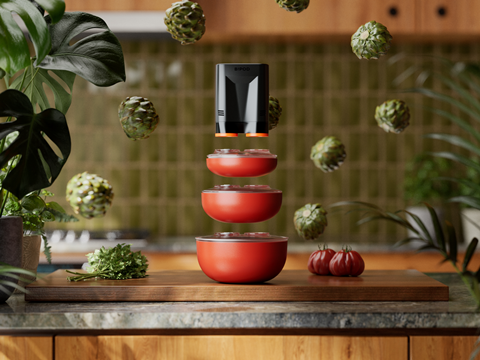
In a move set to eliminate over 300 plastic bags per person and reduce CO2 emissions by 30kg per capita, SABIC’s high-gloss polypropylene resin containing around 50% ‘ocean-bound’ plastic has been incorporated into food-contact vacuum containers from SAES Getters business unit B!POD.
SABIC reports that used plastic collected within 50km of shorelines undergoes advanced recycling to be converted into plastic feedstock – creating a material that is fully certified under the ISCC PLUS chain of custody.
The resultant SABIC PP 576P resin, part of SABIC’s TRUCIRCLE portfolio, is food-contact approved and claims to be PFAS- and BPA-free. Apparently, it is easy to process and provides low warpage, good impact strength, and high gloss when moulded into shape.
To achieve different sizes and colours for the B!POD containers, SABIC’s resin is supplied in its natural colour to thermoplastic resin processor Costruzioni Elettromeccaniche Legnaghesi, where certain masterbatches are applied.
The reusable containers are said to be fully recyclable in existing polypropylene material streams. They have been fully rolled out across the European Union, Switzerland, and the UK this year, and countries in Asia are expected to follow in 2025.
Khaled Al-Jalawi, global director of Circular Economy Business at SABIC, comments: “We are very pleased about working with SAES Getters to help consumers meet the challenge of improving food preservation with a powerful vacuum system that uses containers moulded in OBP-based SABIC PP.
“The decision to replace standard virgin PP by our OBP material in the containers also marks a significant step towards greater sustainability, as it supports the transformation of the plastics economy towards circularity.”
Ginevra della Porta, chief innovation officer at SAES Getters and co-founder of B!POD, adds: “This innovation embraces sustainability from the very concept to end use – with an advanced vacuum technology to minimize food waste, with SABIC’s OBP-based material that prevents used plastic from polluting our oceans, and with containers in a range of colours each dedicated to an endangered species, such as orangutan orange or whale grey, it is designed to raise the awareness of consumers.
“Moreover, our market research has indicated that reusable rigid containers for food preservation can potentially eliminate the consumption of more than 300 non-recyclable plastic bags per person and year, which corresponds to a per capita release of 30 kg of CO2 to the atmosphere.”
Back in 2022, SABIC worked alongside Scientex to recycle ‘ocean-bound’ plastic waste into feedstock to produce flexible plastic packaging for a Malaysian noodles brand. This was thought to contain a mass balance-accounted 30% of ocean-bound plastic while meeting the performance standards of virgin, fossil-based polypropylene alternatives.
Since then, it has joined forces with Estiko Packaging Solutions and Coldwater Prawns of Norway to develop an ISCC PLUS-certified pouch for frozen prawns, with 60% of the multilayer film claiming to contain ‘ocean-bound’ plastic waste. This was hoped to keep plastics in a circular material stream and out of the natural environment.
Retailer Lidl has also incorporated recovered ‘ocean-bound’ plastic waste, or Prevented Ocean Plastic, into a one-litre sparkling water bottle. The move was hoped to keep almost 4 million plastic water bottles out of the oceans every year.
In an edition of The Brief published earlier this year, we covered the use of ‘ocean-bound’ plastic in packaging – how it is being implemented and why various industry players believe in its merits.
If you liked this story, you might also enjoy:
The ultimate guide to the Packaging and Packaging Waste Regulation in 2024
How are the top brands progressing on packaging sustainability?
Sustainable Innovation Report 2024: Current trends and future priorities
Everything you need to know about global plastic sustainability regulation




















No comments yet